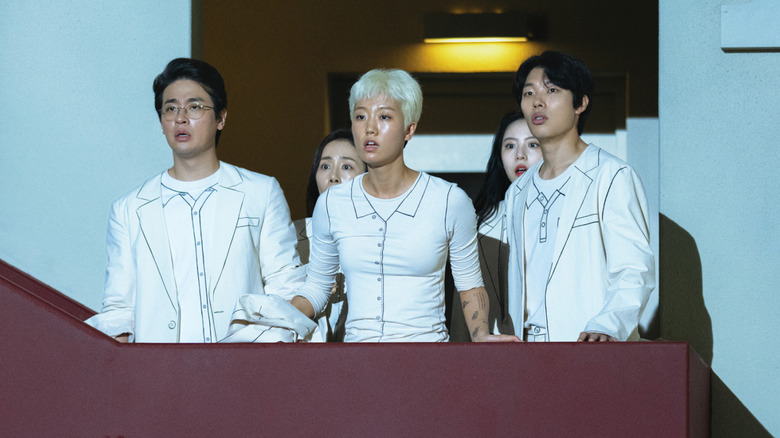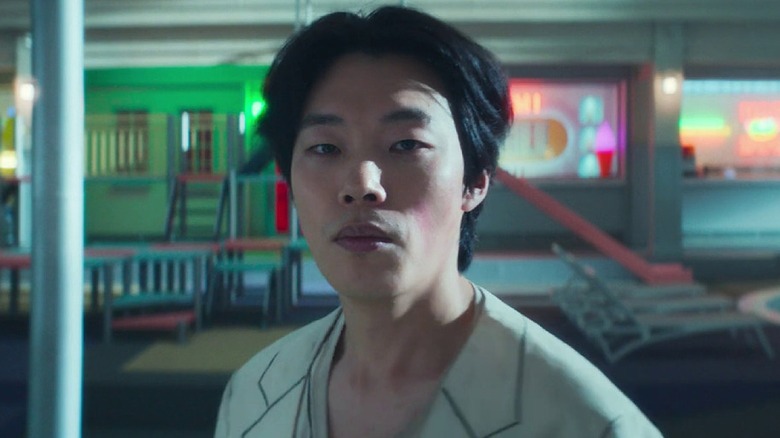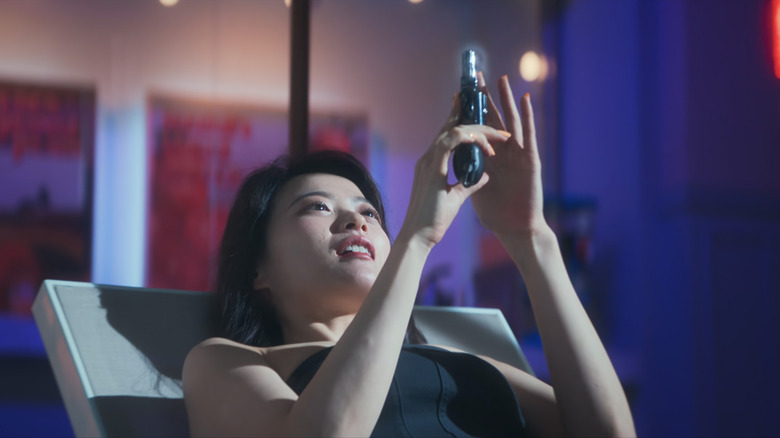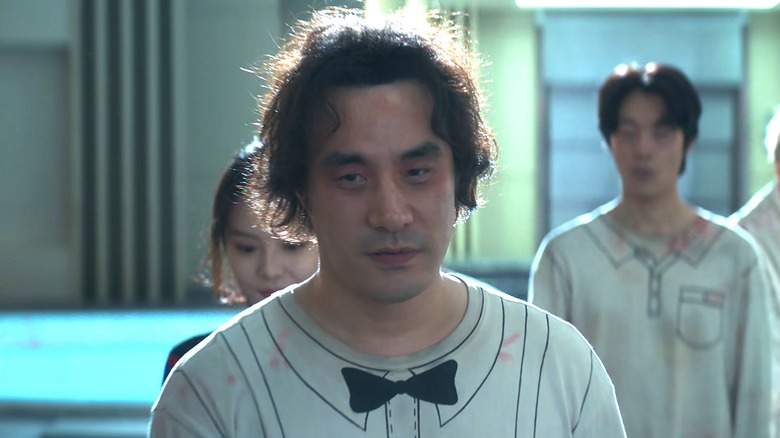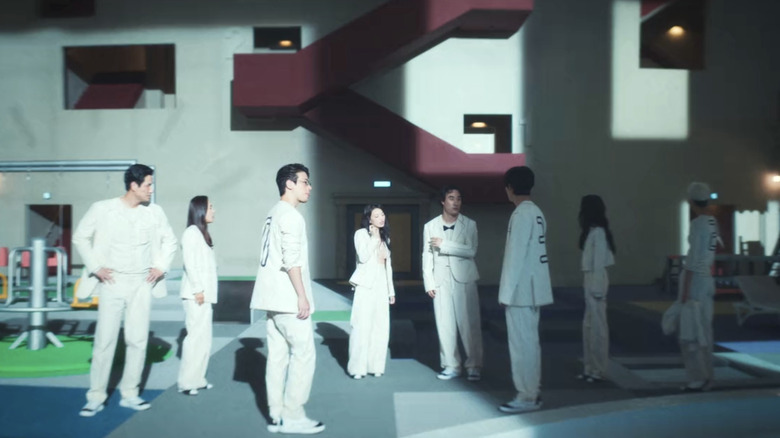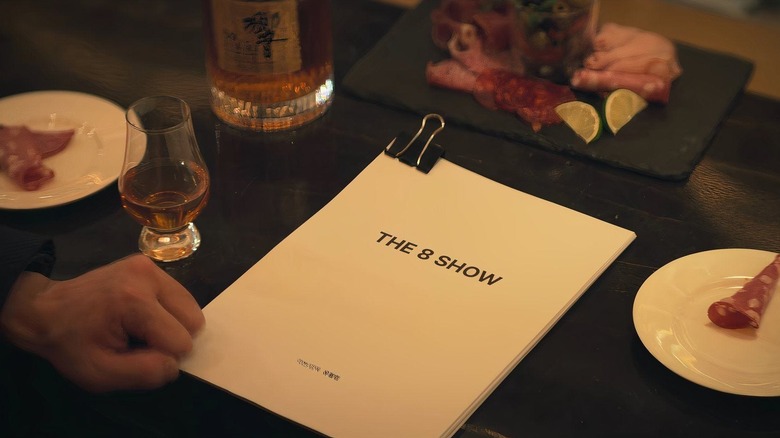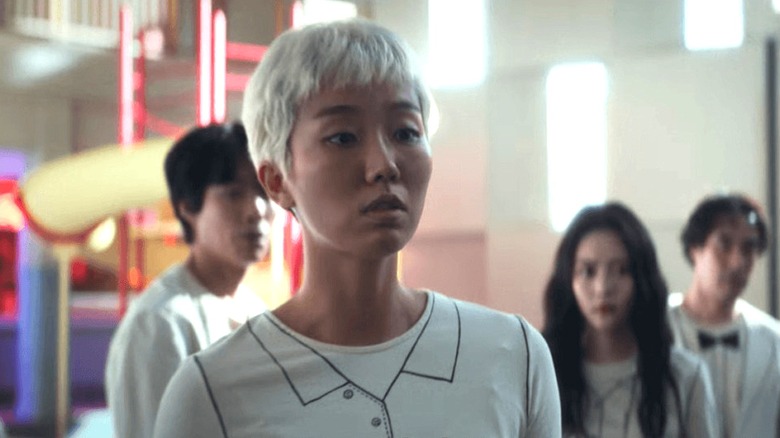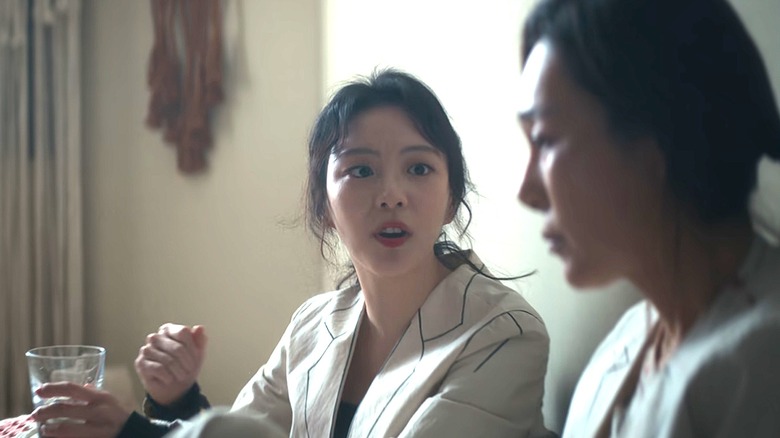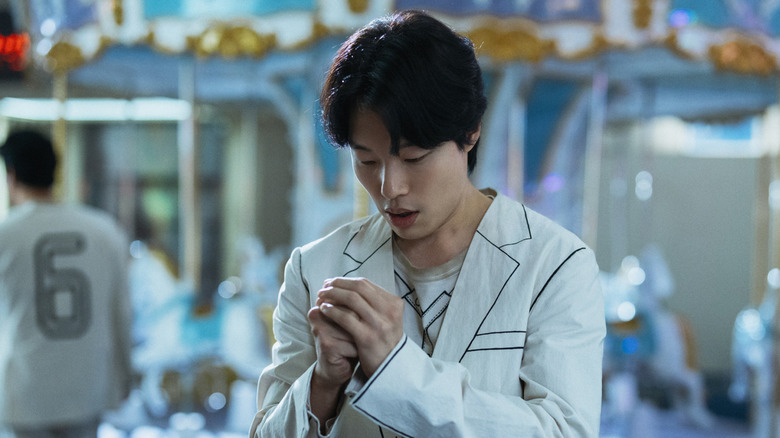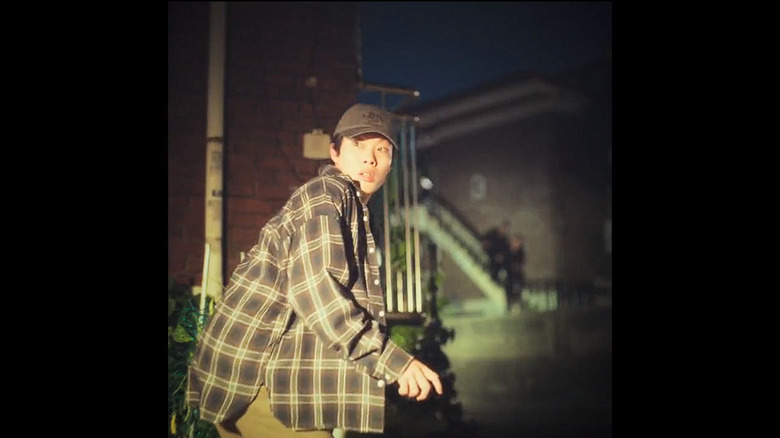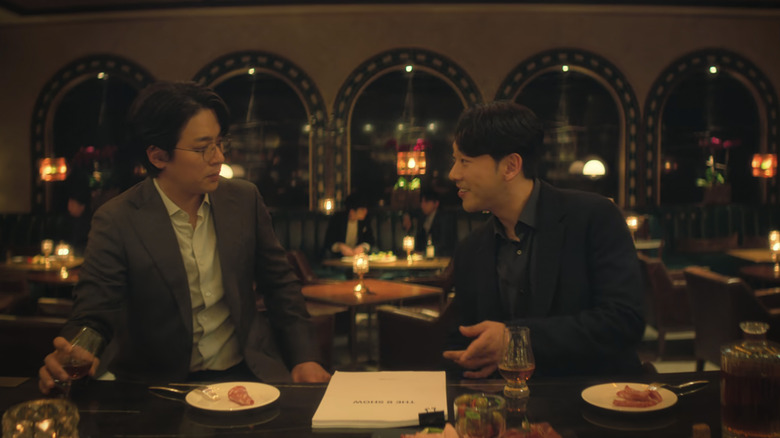The Ending Of The 8 Show, Explained: Clearing Up Netflix's Confusing Horror Show
The Korean psychological horror drama "The 8 Show" took Netflix by storm in 2024, presenting a new take on the survivalist game show subgenre. Adapted from an unexpected piece of source material — in this case, a webtoon — "The 8 Show" presents us with eight individuals vying for billions in prize money. Their goal? To last as long as possible in an austere building where time must be earned through providing entertainment to viewers.
Though it's often compared to "Squid Game," which explores the nature of human morality and the fundamental natures of good and evil, "The 8 Show" takes a different approach to its subject matter. With heavy-handed messaging, the series examines real-world problems, delving into social class and economic structure to drive home issues of inequality and state corruption. A slow-build thriller that starts with a simple problem, the story quickly snowballs as contestants on "The 8 Show" learn the rules of the game. And with each new revelation comes a twist, usually escalating the terror each time.
By the end of the eight-episode series, viewers may have trouble discerning exactly what exactly happened. But that's why we're here: To explain the ending of "The 8 Show," and how it's designed to hold a mirror up to modern society.
What you need to remember about the plot of The 8 Show
In "The 8 Show," we follow eight individuals who have been selected to take part in what appears to be a reality TV series. They are given almost no information before they join the show other than that there's the potential to win enormous monetary prizes. When they enter the game, each of them is assigned to live on a different floor of an eight-story building, chosen based on a numbered card they selected before they entered. We soon discover, though, that each floor provides a very different experience for each person.
On the bottom floor, the participant lives in a room barely big enough for one person, with each successive floor featuring larger rooms. Each room contains a machine that will provide any goods a person might want, but they must be purchased out of their monetary earnings. The real twist, though, is that each contestant earns a different amount of prize money per hour, which allows those on the higher floors to buy themselves more comforts. The woman on the eighth floor, for example, eventually purchases a luxurious bed, extravagant clothes, and other frivolous items, while those on the lower floors live with very little.
At the same time, only the top floor, the 8th Floor, is provided food and must be convinced early on to share it with the lower floors so that everyone can eat. To earn more time and, thus, more prize money, the participants must also provide entertainment for the Showrunners — the people responsible for the games — and whoever else may be watching.
The most disturbing rules of The 8 Show
The rules of "The 8 Show" are convoluted, to say the least. But what makes them even more confusing is the fact that we don't learn them all at once. Even the contestants are confused by them at times. For example, while the floors allow each participant to earn money at a different rate, there is still another way for them to purchase goods — in the "town square," the building's communal area.
In the town square is a clock that starts at 24 hours and counts down time until the show ends. Contestants can add more time to the countdown by being entertaining, but that's not all: they can purchase items as a group by sacrificing time on the clock. But because each floor earns a different amount of money per hour, it's more advantageous for the lower floors to get shared goods via the town square, while the upper floors would rather purchase their goods with their massive earnings. This eventually leads to a power struggle where the top floors — who can afford expensive items like weapons — force the lower floors to provide all of the entertainment.
Eventually, the participants learn that conflict, violence, and injury add the most time to the clock, so the upper floors make the lower floors participate in dangerous games. But near the end of the series, we learn one important rule that only the 1st Floor has figured out: for a price of one billion won, any player can switch rooms with another contestant.
What happened at the end of The 8 Show?
Midway through "The 8 Show," 4th Floor decides to ally herself with the upper floors. This includes 8th Floor, who has no apparent empathy for anyone else; 7th Floor, a brilliant and astute man who seems set on ensuring everyone gets out with as much prize money as possible; and 6th Floor, a devious, violent, vindictive man who is determined to crush his lower competition.
Together, 4th, 6th, 7th, and 8th Floors become a kind of decadent ruling class, uncaringly forcing the other floors to earn more time for the group by tormenting them with violent games and threatening them when they even think about fighting back. But eventually, the lower floors do revolt and successfully overthrow the upper floors, who they keep tied up as their prisoners. When 5th Floor shows sympathy, however, the upper floors manage to regain power, leading to even more brutal torture.
Soon, 4th Floor betrays the upper floors and manages to lead a second revolt and strike an agreement to allow the clock to reach zero so the game will end. But just before it does, 1st Floor — the poorest — refuses to end the game. Then, in an ill-fated attempt to provide more entertainment to the showrunners, he's killed in a tragic accident, ending the game. Once released, 3rd, 4th, 5th, and 2nd Floors meet on the outside for a private funeral for 1st Floor. When they go their separate ways, most are far richer than they were before the show.
What did the ending of The 8 Show mean?
In short, the entire show-within-the-show is a metaphor for the real world's class divide, and often a stinging critique of capitalist economics. The randomness of the room selection via a numbered card represents the lottery of one's birth, and whether you are born into a lower, middle, or upper-class home. In the real world, time is worth more to those with a higher income, and the show illustrates this in literal fashion.
Likewise, lower-floor participants in "The 8 Show" have more meager means and rely on the generosity of the upper floors to provide necessities like food, medical care, and even toiletries. The wealthy have all the power, forcing the poor to provide the labor that earns them all money, while the upper-class is required to do very little beyond exploiting those beneath them to maintain their wealth.
At the end of "The 8 Show," with the death of 1st Floor — the result of his desperation to finally have the extravagant lifestyle he was so envious of — the message is clear. The rich will always have it easier, not just because of their existing wealth but because getting even wealthier is much easier and involves very little actual labor. Meanwhile, attaining any wealth at all is nearly impossible for the poor, despite working their fingers to the bone for their entire lives.
Who were the Showrunners?
Throughout "The 8 Show," we hear repeated references to the Showrunners — the mysterious group of people who have created the show-within-the-show. They're clearly wealthy, to an almost unimaginable degree, and are able to arrange the entire proceedings while offering hundreds of billions to the participants. But we never once meet them. So who are they? The reality is, it doesn't really matter: They are the real upper class, who use the poor (the participants) as their own private entertainment; the show is never publicly televised as far as we can tell.
At the end of the series, in a post-credits scene, we see 7th Floor after he's gotten out of the game. We learn that he is a scriptwriter, and after one of his failed projects is laughed at by a wealthy producer, he presents a new pitch based on his experiences in the building, titled, of course, "The 8 Show." Now, it would appear, the entire experience will indeed become a show for the masses. This could also be seen as a critique of "Squid Game," Netflix's own reality show drama that eventually became an actual reality show, completely ignoring the dire warnings of the show itself (though the streamer may rethink its approach since "Squid Game" got them sued).
Why did the participants choose their floor numbers?
When we first meet the eight participants of "The 8 Show," we know almost nothing about them. They are seemingly chosen at random, with their floors selected based on a numbered card they drew before entering the building. The randomness is important, as it represents the arbitrary nature of whether a person is born into poverty, wealth, or something in between, and how that largely decides what station in society they'll have for their entire lives.
Yet, there are signs that perhaps the number choices weren't quite as random as it seemed. While none of the participants were truly wealthy before entering the 'show,' we eventually learn that 6th Floor was once a successful athlete and 8th Floor was once a rich artist who squandered her money. Meanwhile, 1st Floor lived in poverty, 2nd Floor struggled to get by, and 3rd Floor was in tremendous debt from his role in a get-rich-quick scheme.
Once we learn exactly who they are outside of the game, their floor assignments seem less random. It's entirely possible, then, that the selection of the numbered cards was a statement, too; each participant may have instinctively chosen a number based on where they were in life — or where they thought they deserved to be. This explains why 4th Floor, a lower-middle-class woman who envied the rich and would do anything to attain wealth, initially picks card #8 — it's where she instinctively feels she should be — before switching to #4 — where she actually was.
Who were the 8 participants?
At the outset, we know almost nothing about the eight participants, but that slowly changes throughout the series. Each episode flashes back to before the start of the game, and we get glimpses of who each person was before they entered the building, beginning with 3rd Floor. A young man working paycheck to paycheck, he's always looking for an opportunity to get rich and falls victim to a scam from a man who convinces him to invest in a new, risky business venture. He winds up hundreds of millions in debt, making him just desperate enough to accept the game's tantalizing offer of billions in potential prize money.
2nd Floor is another wage slave, but one who doesn't seem to have the same drive for wealth. She's only participating to help a coworker who's in dire need of money for medical care. Likewise, 1st Floor is a member of a struggling circus, lives with persistent health problems, and whose daughter will die if he can't pay for her medical treatment. 4th Floor was a young woman who once had big dreams and big potential, but who now toils away as a parking attendant. 5th Floor was an ordinary middle-class woman.
In the finale, we learn about the final three participants. 6th Floor is an ex-baseball player who lost everything in a gambling scandal, while 7th Floor is a struggling entertainment writer attempting to sell a new script. 8th Floor was once a wealthy socialite artist, but she too lost all of her money; she also seems to view life and money as little more than a game.
Why did we never learn more about the participants?
By the end of "The 8 Show," it's hard not to see what the series is trying to say about the world. Something viewers may still be wondering about, though, are the personal lives of the eight participants. Throughout the show, we learn only what little we need to know to understand them, and that was by design, according to director Han Jae-lim, who spoke about the nature of the different characters.
"I felt this was the story that anyone can relate to in the age of capitalism," Jae-lim told The Korean Times. "I wanted to create a hierarchy by naming the characters by their floor. And I tried to make it easier for [the audience] to empathize with any of the characters by not providing them with detailed backstories." As the director tells it, the vagueness of each character was intentionally designed to allow audiences to see themselves in any of them — just as he does.
As a result, envisioning themselves as one of the participants helps the audience truly understand the ethical dilemmas at play, and that was important to Jae-lim. "I wanted to create a work that not only entertains but also raises questions and discussions about such issue."
What does director Han Jae-Kim say about the meaning of The 8 Show?
"The 8 Show" ends with a revolution against the upper floors by the participants living on the lower floors. An unsubtle allegory for class warfare, the meaning behind the floors' fight goes even deeper according to director Han Jae-lim, who talked about how certain elements of the competition had eerie similarities to the creative arts.
"I found [the participants'] predicament strikingly relatable to our own," he said in an interview with Korean Film, comparing the players' need to entertain in exchange for extra time and prize money to his role as a director. Whether a creator is a director, writer, actor, or even a YouTube influencer, Jae-lim said that he believes that it's becoming harder and harder to keep audiences engaged. "We are competing with more sensational and easier projects with weaker narratives, and the slow cinema and classic movies that we know of are fading."
With this explanation, it's easy to see how 7th Floor, a screenwriter eager to develop a script that will keep viewers hooked, could be the character Jae-lim sees himself in most.
Why did The 8 Show use 2 different aspect ratios?
The first character we meet in "The 8 Show" is a young man named Jinsoo, who will later be known as 3rd Floor. When we meet him, he's on the run from a pair of thugs who are there to collect on a debt. The entire sequence unfolds in a 1:1 aspect ratio, a pure square even smaller than the 4:3 aspect ratio that was the standard for 20th-century television shows. Once he enters the game, however, the series switches to full widescreen.
Throughout the remainder of the series, whenever we flash back to learn more about the lives of the participants, the show returns to that 1:1 aspect ratio. "I aimed to depict the characters' confined reality," director Han Jae-lim said in his interview with Korean Film. "Their lives are constrained within a 1:1 aspect ratio," he added, explaining that he wanted to show how their lives actually became bigger within the world of the game. "I wanted to create the impression of the show looking more real than their actual reality."
More than just an attempt to demonstrate the claustrophobia of the participants' outside lives, the varying aspect ratios are a statement on cinema itself. "I wanted to hint that the series possesses meta-cinematic characteristics, particularly as Jinsoo enters the film set."
How does the Ending of The 8 Show compare to the original web series?
Many fans are probably aware that "The 8 Show" was adapted from a popular Korean web series, but what some may not realize is that the Netflix adaptation actually combines two works from creator Bae Jin-soo: "Money Game" and "Pie Game." However, while "The 8 Show" pulls ideas from both, it also fundamentally alters some aspects.
The original "Money Game" was more of an austerity play; participants simply had to see how far they could make their money go in order to leave the game with as much cash as possible. In "Pie Game," however, time (and thus money) can be added by playing violent games, purchases are made via a shared pot of prize winnings, and more time can be earned by committing acts of violence.
In the original "Pie Game" webtoon, 1st Floor isn't the sympathetic figure we meet in the Netflix version. Instead, he's actually the story's biggest villain. Director Han Jae-lim, in his Korean Times interview, explained that when the story morphed the characters into a more direct allegory for social classes, it became necessary to make 1st floor a sympathetic figure, even going so far as to portray him as a Charlie Chaplin-esque type of character.
Could we see a sequel to The 8 Show?
Admittedly, there's very little left to say by the end of "The 8 Show." By the time the final episode draws to a close, the series has made its point clear about class warfare, capitalism, and the benefits of a communal society, as well as the ways the modern world brutalizes those on the lower rungs of our society. Of course, when any series is a hit, we're forced to ask if there will be a sequel, or, in this case, a second season.
While the series wraps up its story neatly, there are plenty of directions a follow-up could go, starting with the impact the experience had on its participants and what they did with their winnings (outside of 3rd Floor, who uses all of his money to arrange 1st Floor's funeral). But perhaps more interestingly is the post-credits stinger, which teases the creation of a new TV show written by 7th Floor, based on his experiences as a contestant on "The 8 Show."
More importantly, however, director Han Jae-lim has already teased a second season. In his interview with Korean Film, Jae-lim says that he promised creator Bae Jin-soo a cameo in a possible sequel season. Of course, Netflix could very well opt to do what they did with "Squid Game" and create a reality series based on the show, with less violent games, of course. But would it rank on our list of best reality shows?
